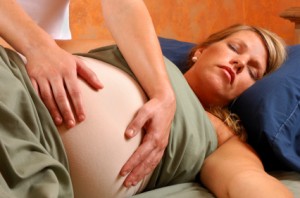A Midwife's Voice: Mindbody Care for Pregnancy and Birth
By: Kathy Morelli | 0 Comments
This is a guest post by Trish DeTura, RN, CNM, MS, MAMA President
 Pregnancy is such an exciting time in a woman's life filled with the great wonder of what is to be. However, it may also be a time of great stress as a woman's body goes through a great metamorphosis. Some of the common discomforts of pregnancy are round ligament pain, indigestion, aching back and pelvic pressure, just to name a few.
Pregnancy is such an exciting time in a woman's life filled with the great wonder of what is to be. However, it may also be a time of great stress as a woman's body goes through a great metamorphosis. Some of the common discomforts of pregnancy are round ligament pain, indigestion, aching back and pelvic pressure, just to name a few.
Add to this list the mental/emotional challenges a woman experiences in pregnancy surrounding the uncertainty around motherhood, sadness and depression.
One wonders as a practitioner, what can I offer this woman that will benefit her and her unborn baby?
While attending the Art of Birthing Conference in the New York Academy of Medicine in 2000, I found a wonderful complementary technique.
Complementary techniques are popularly used by many women for the relief of aches and pains during pregnancy and birthing (Jones et al, 2012). Leanna Jones and her colleagues (2012) found complementary methods were most often offered and used in midwife-led births. Relaxation, acupressure/acupuncture, massage and immersion in water were found to provide pain relief and positive maternal outcome without invasive side effects. Also, regarding acupuncture/acupressure, a decrease in the use of forceps, ventouse and cesarean section was noted (Jones et al; 2012).
I learned about Maya Abdominal Massage from Rosita Arvigo and Ms. Hortense Robinson. Rosita is a naprapath, herbalist and teacher of Maya medicine. She who apprenticed with Don Elijio Pante, a traditional Maya healer, in Belize, Central America. Ms. Robinson is a midwife.
They shared how the Arvigo Technique of Maya Abdominal Therapy (ATMAT), restores the body to its natural balance by correcting the positions of organs that have shifted and restrict the flow of lymph, blood, nerve and qi energy. Thus, ATMAT promotes homeostasis.
As a result of ATMAT, the pregnant woman experiences an increase of arterial blood carrying oxygen, nutrients and minerals to the mother and her unborn along with removal of any waste via the venous system and lymph. In addition, the mom experiences a removal of any congestion or blockages enhancing better hormonal, nerve flow and flow of chi.
I thought this all made good physiologic and common sense. I was hooked! Onward to learning this technique to support women with all kinds of challenges then onward to learning the pregnancy aspect of this method.
This gentle, non-invasive approach of this abdominal massage begins at 20 weeks of gestation continuing up to when the woman delivers. ATMAT eases the common discomforts of pregnancy.
I find it to be a lovely complement to a midwifery practice, the mom gets to focus on her baby and her developing baby intimately, thus preparing her to open psychologically and physically to her pregnancy and birth.
Tiffany Field, Ph.D. at the Touch Research Institute in Miami, has collected extensive data on the profound healing effects of touch, which is what ATMAT is- healing and nurturing touch- for both the mother and her unborn.
In the Journal of Psychosomatic Obstetrics and Gynecology, Field (2010) published a study demonstrating that regular massage during pregnancy results in: decreased anxiety, improved mood, reduced back pain, improved sleep patterns, reduced stress hormone levels, fewer complications during labor and fewer complications for infants following birth.
Further, Field (2010) reports women who have received massage therapy experienced significantly less pain and their labors were on the average three hours shorter.
The data collected by the midwives providing ATMAT to their pregnant clients supports these findings. In addition to the shortening of labors, mothers who receive ATMAT bond with their unborn baby leading to less postpartum depression. This has been substantiated by Dr. Tiffany Field and her colleagues in a 2009 study revealing that postpartum depression was lessened as a result of prenatal massage.
It is my hope that one day the Arvigo Technique of Maya Abdominal Therapy will be recognized as an essential and vital aspect of maternity care. To learn more about this great modality please go to: www.Arvigotherapy.com
References:
Field, T. (2010). Pregnancy and labor massage therapy. Expert Review of Obstetrics and Gynecology, 5, 177-181.
Field, T., Diego, M., Hernandez-Reif, M., Deeds, O., & Figueiredo, B. (2009). Pregnancy massage reduces prematurity, low birthweight and postpartum depression. Infant Behavior & Development, 32, 454-460.
Jones L, Othman M, Dowswell T, Alfirevic Z, Gates S, Newburn M, Jordan S, Lavender T, Neilson JP.Pain management for women in labour: an overview of systematic reviews. Cochrane Database of Systematic Reviews 2012, Issue 3. Art. No.: CD009234. DOI: 10.1002/14651858.CD009234.pub2
Trish DeTura, RN, CNM, MS specializes in the Arvigo Technique of Maya Abdominal Massage, a non-invasive and natural technique of restoring health to the reproductive organs. She is in private practice in Hoboken, NJ. Contact her at trishdetura@gmailcom
Published: April 27, 2012
Tags
PregnancyMidwifery CareMidwifeRelaxationRelaxation In ChildBirthComplementary TechniquesMassageMaya Abdominal MassageMindbody Techniques